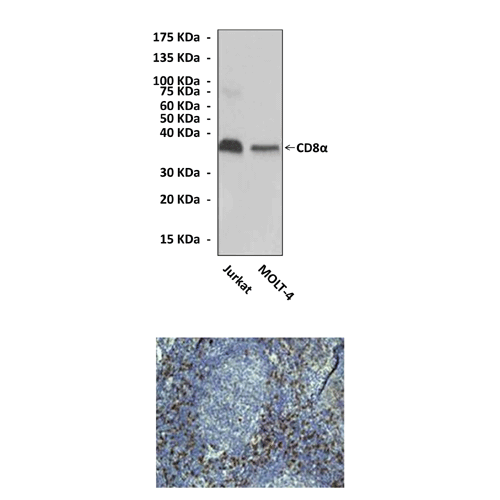Anti-CD8: Rabbit CD8 Antibody |
 |
BACKGROUND The CD8 molecule is a cell surface glycoprotein that is expressed predominantly on class I MHC-restricted T cells. It is composed of a 36-kD alpha chain and a 30-kD beta chain. CD8 is expressed as a disulfide-linked homodimer, the alpha-alpha; predominant form expressed on natural killer cells and intestinal gamma-delta; T cells, or as an alpha-beta heterodimer, the form found on most thymocytes and peripheral T cells.1
CD8 functions as a co-receptor for cytotoxic T lymphocytes (CTLs), interacting with a nonpolymorphic region of the major histocompatibility complex (MHC) class I a3 domain on antigen-presenting cells. The CD8 co-receptor can modulate CD8+ T cell function through its contributions to T cell receptor (TCR) binding and signaling.2 The CD8 alpha-beta co-receptor amplifies the CD8+ T cell response to peptide/MHC Class I complexes on antigen-presenting cells (APC) by at least four mechanisms. First, CD8 binding to nonpolymorphic regions of the MHC molecule and beta 2-microglobulin is thought to stabilize the interaction between the TCR and peptide/MHC complexes. Second, CD8 binding to the MHC augments TCR signaling via activation of p56lck and LAT. Third, CD8 is thought to induce the co-localization of receptor complex molecules onto lipid rafts. Fourth, CD8 induces a conformational change in CD3 that is necessary for signal transduction.3 Modulation of surface CD8 expression on naive and effector cells can therefore alter the threshold peptide/MHC levels required to trigger proliferation, cytokine production and target cell lysis,4 effectively “tuning” the T cell response.
REFERENCES
1. Zhong L et al.: Acta Crystallogr Sect F Struct Biol Cryst Commun. 66:435-438, 2010.
2. Choksi S et al.: Nature Med. 4:30 –314, 1998.
3. Parnes JR: Adv Immunol. 44:265-311, 1989.
4. Xiao Z et al.: J. Exp. Med. 204: 2667-2677, 2007.
2. Choksi S et al.: Nature Med. 4:30 –314, 1998.
3. Parnes JR: Adv Immunol. 44:265-311, 1989.
4. Xiao Z et al.: J. Exp. Med. 204: 2667-2677, 2007.
Products are for research use only. They are not intended for human, animal, or diagnostic applications.
Параметры
Cat.No.: | CG1649 |
Antigen: | Short peptide of human CD8 alpha sequence close to the carboxyl-terminus |
Isotype: | Rabbit IgG |
Species & predicted species cross- reactivity ( ): | Human |
Applications & Suggested starting dilutions:* | WB 1:1000 IP 1:10 IHC 1:250 ICC 1:100 FACS 1:40 |
Predicted Molecular Weight of protein: | 36 kDa |
Specificity/Sensitivity: | Detects endogenous levels of human CD8 in normal cells and tissue. |
Storage: | Store at -20°C, 4°C for frequent use. Avoid repeated freeze-thaw cycles. |
*Optimal working dilutions must be determined by end user.
Информация представлена исключительно в ознакомительных целях и ни при каких условиях не является публичной офертой








